How to master the the PM homework assignment
|
|
|
Background | Frame the problem | Make it pop | Acknowledge gaps | Summary
Testing for the skills that product managers need to succeed in an interview environment is notoriously difficult.
As a result, many leading tech companies like Airbnb, Uber and Twitter, have introduced a PM interview homework assignment, also known as a "take-home", that candidates must complete as part of the process.
A typical homework assignment presents a product problem (e.g., "Explain how you'd solve for..."), a suggested time commitment (e.g., "Spend no more than 6 hours...") and sometimes comes with an associated data pack (especially for analytically oriented roles).
Why do companies use PM homework assignments? (Top)
Simple answer: it provides deeper insight into how a candidate problem solves.
In contrast to questions asked on-the-fly in interviews, a homework assignment allows the candidate time to think deeply about the challenge, the problem space, wrestle with associated data (if included) and propose solutions. Since the time constraint is relaxed, candidates don't have to worry about responding with the first thing that comes to mind (which is often what happens in in-person interviews due to nerves, etc.).
At its best, the homework assignment acts like a job simulation - which is helpful for both the candidate (to evaluate whether they like the role) and for the company (to evaluate whether the candidate is a good fit).
"It helps get deeper into the topic because the person had time to prepare. You can really see how the candidate is capable of structuring a plan and his/her ability to articulate it in a simple and convincing way, which are things [the candidate] would have to do to lead a product team."
Thibault Imbert, Director of Growth for Adobe Creative Cloud
Three tips for a PM homework assignment
Next, we'll walk through three tips for approaching your PM take-home assignment.
- Frame the problem
- Bring the solution to life
- Acknowledge the gaps
To bring things to life, we'll show sample slides from an actual PM take-home exam that our Founder, Kenton Kivestu, put together in February 2013 for Uber. While it's far from perfect, it did result in a PM offer and serves as a useful illustration of how to approach to exercise.
#1: Frame the problem (Top)
The first critical task is to frame the problem.
As a PM, you'll face myriad problems every day and you'll have to prioritize 1) which problems to solve and 2) how to solve those particular problems. The PM homework assignment typically drills deep into the latter part, striving to see how you work when you have some breathing time to explore the problem space - which is often a realistic approximation of the on the job experience.
There are a ton of ways to do this and your particular approach will be part of your personal style. That said, here is one example of a way to do it:
- State the problem clearly (e.g., "The goal is to improve DAU...")
- Define how you'll approach the problem (e.g., "To improve DAU, I'll focus on increasing existing user retention")
- Lay out hypotheses to address the problem (e.g., "To increase retention, we could explore X, Y and Z")
Example: Framing the Uber driver screen problem
In this particular homework assignment during the early days of Uber, the problem statement was broad: design a better driver home screen for Uber drivers.
Stating the problem: Clearly stating the problem to be addressed in the exercise
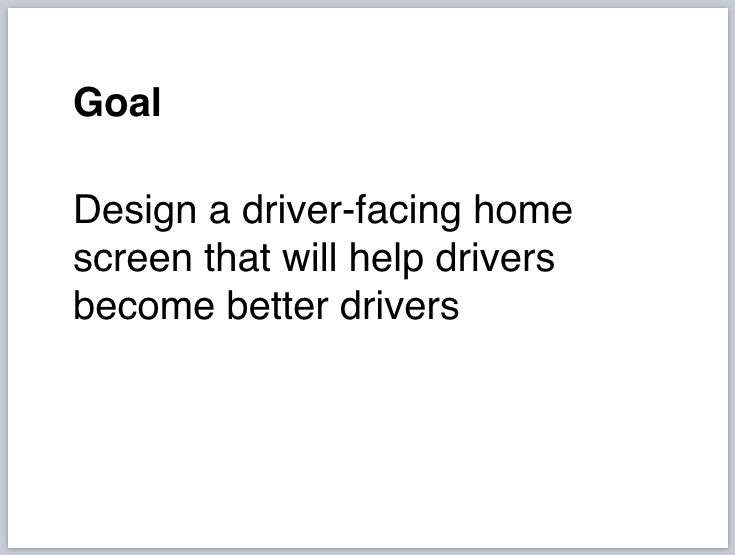
Framing the approach: Defining how the candidate is constraining the problem and hammering it home with a visual
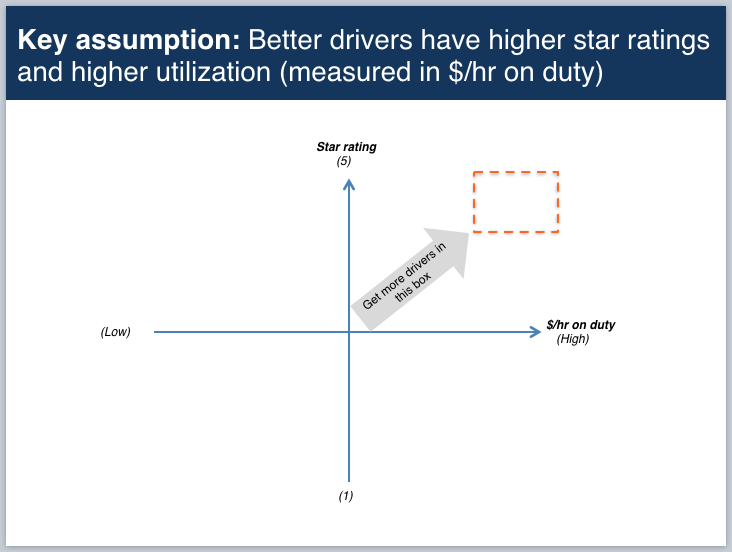
Laying out hypotheses: Giving a window into the view of the variety of considered approaches
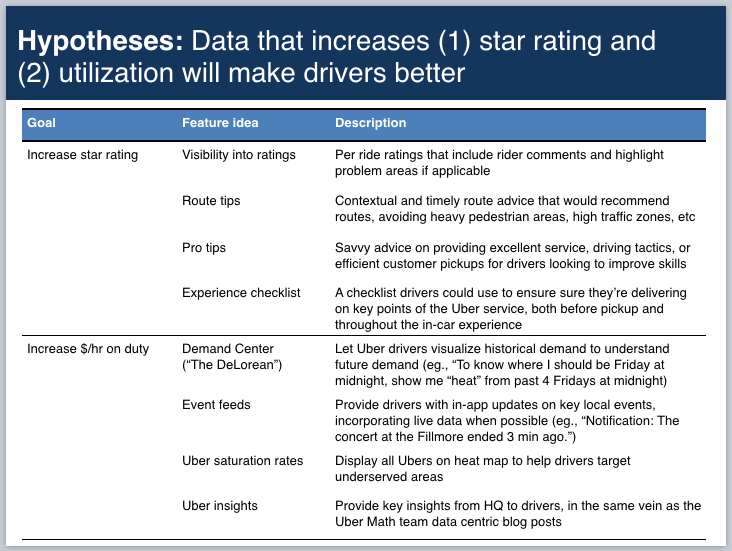
#2: Bring the work to life (Top)
Next, you want to make your solution jump off the page.
Bring your solutions to life by using wireframes, well-built charts and data displays and images that evoke the right sentiment as appropriate.
Obviously, some text is helpful but where possible, show (instead of tell) how your solution might work. PMs like this because it mimics the type of communication and work-shopping that they might do internally with their engineering teams and other stakeholders.
Tactical tip: If you're making wireframes, hand-drawn can work if you're a decent drawer or using a tool like Balsamiq or Sketch can help. For analytically heavy exercises, where wireframes don't make sense, consider displaying quantitative insights in a visually compelling manner (e.g., starting with a single chart that illustrates the point).
Example: Bring the solution to life
Wireframe #1: Provides a glimpse of the 1st proposed feature with key ideas highlighted
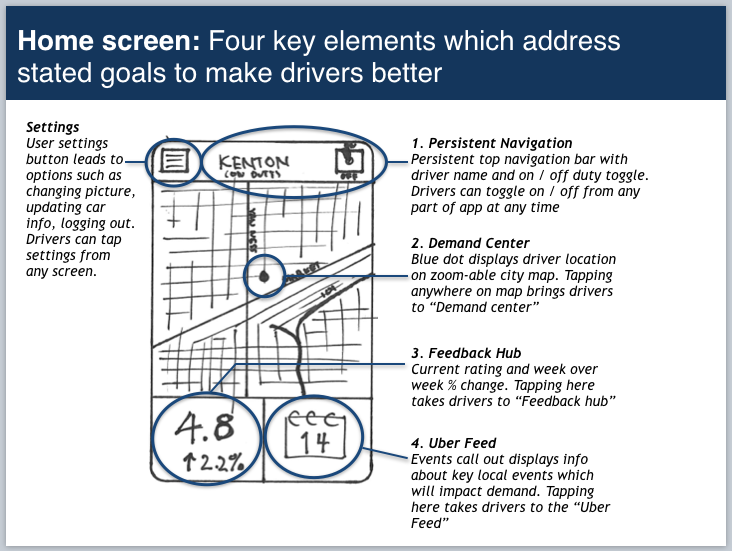
Wireframe #2: Shows a view of the 2nd proposed feature
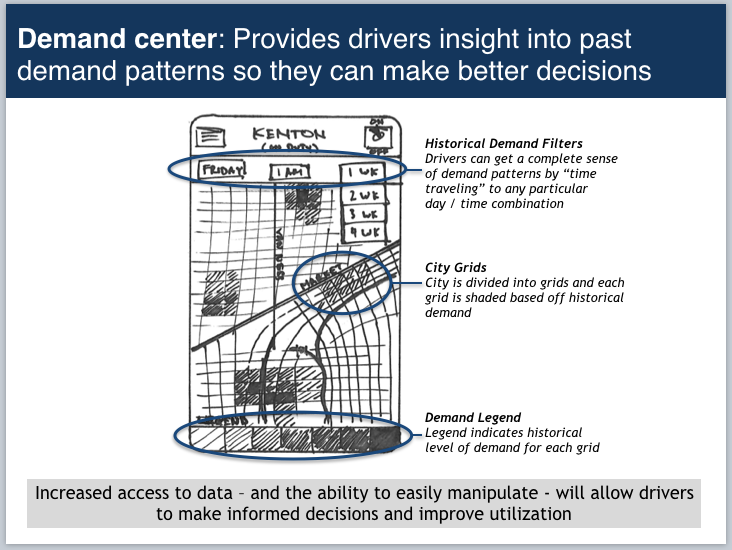
Wireframe #3: Additional details on the 2nd proposed feature
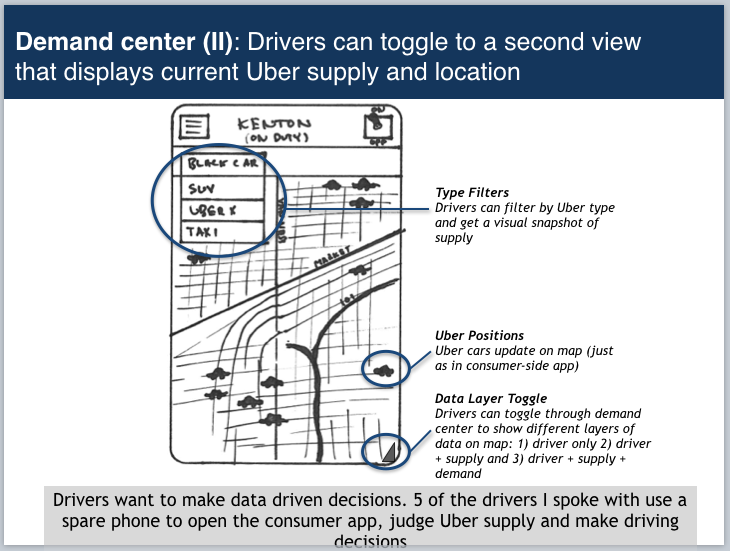
#3: Acknowledge the gaps (Top)
Finally, no solution is perfect - even the ones that get implemented in real products!
Acknowledging and highlighting the key drawbacks from your proposed solutions demonstrates a maturity in your approach to product development. It shows your cognizant of downsides and can push the discussion forward to how to mitigate issues versus trying to sweep them "under the rug."
Depending on the particular problem, you could also highlight next steps that the team should consider taking.
Example: acknowledging gaps and issues with the solution
Acknowledges the potential risks with proposed solutions and highlights some ways to mitigate (e.g., A/B testing carefully)
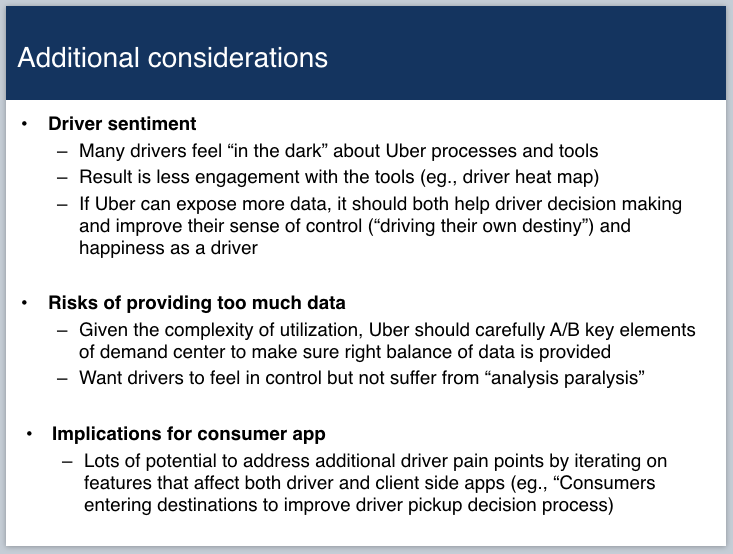
Summary: one last thing (Top)
Finally, remember that a PM homework assignment isn't the interview in and of itself. Rather, it's a starting point.
You should be prepared to defend your process, articulate it clearly and discuss the alternatives you discarded. Again, remember that the homework assignment is a tool to replicate the on-job experience and, as a result, arriving at a solution will likely involve collaboration and discussion with your team - even if you are the ultimate decider!
Lastly, have fun with your homework assignment. If the homework assignment itself isn't any fun for you, it's possible the role isn't the right match for what you're looking for.
Read this next:
- How to land a PM job using RocketBlocks
- Doing a product deep dive
- PM interview preparation plan
- Three key ways to prepare for PM interviews
- Interviewing PMs (interviewer perspective)
- Learning about the product org
- PM interview prep next steps
- PM interview prep plan
- Success metrics PM interview questions
- Favorite product PM interview answer
- Cracking PM behavioral interviews
- Product management in fintech
P.S. Are you preparing for PM interviews?
Real interview questions. Sample answers from PM leaders at Google, Amazon and Facebook. Plus study sheets on key concepts.



